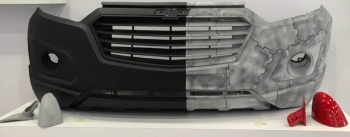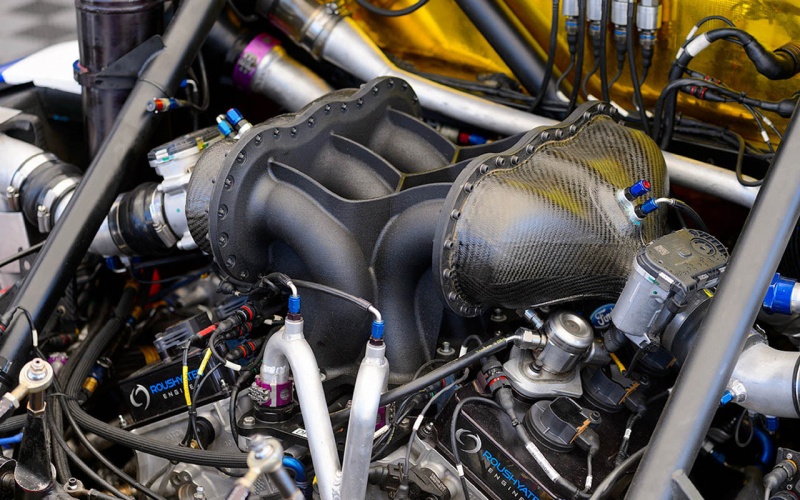
The automobile has changed quite a bit since Karl Benz invented the motorcar in 1886 and a great majority of those changes are attributable to technological advancements in manufacturing. As manufacturers created new methods of fabricating different materials into ever-more complex shapes and configurations, cars became more efficient, powerful, safe, comfortable, and stylish. The march of progress continues today in the form of 3D printing as manufacturers around the world adopt the technology, including those in the automotive industry. This is evidenced by the rapid growth of the market value of 3D printing in the automotive space, which is projected to reach $2.5 billion by 2023. Let’s examine how the industry is currently leveraging 3D printing and consider how it might change in the future.
Prototyping and Validating New Components
Car manufacturers have been using 3D printing to check form and fit as well as validate the operation of functional prototypes. For some full-size prototyping such as checking the fit of a rear-view mirror, affordable FFF / FDM technology can be used. For functional applications that require tougher parts or smoother finishes like mounts or aerodynamic components, resin & powder based technologies that can work with composites and nylons are preferred. Material jetting & 3D Inkjet is often used for full-color display models and miniatures.
Making Manufacturing Tools
Perhaps the second most popular use of 3D printing in the automotive space is fabricating manufacturing aids like jigs and fixtures. Making manufacturing tools using traditional means is rather costly and time consuming, and limitations on geometry translate into both less efficient manufacturing processes and more constraints on the geometry of end-use parts. Manufacturing tools that are 3D printed are lighter and more ergonomic, making it easier and safer for factory workers to perform their duties. That saves time and money on the factory floor.

3D printed sensor fixture (890 x 1010 x 110 mm), made with a BigRep large scale 3D printer
Injection molds for plastic parts and casting cores for metal parts can also be 3D printed, allowing for more design freedom using traditional manufacturing methods and materials. Additionally, topographical optimization is becoming standard practice across the industry, where the geometry of parts is optimized to achieve the strongest shape while requiring the least amount of material. These algorithmic designs are generally more organic in their structure, which makes them difficult or impossible to produce without using 3D printing somewhere along the chain. GM, Volvo, Ford, and many others use 3D printing to produce manufacturing aids to save money, improve designs, and cut lead times. BMW even 3D printed an orthotic device that relieves thumb stress for their plant workers when they’re completing assembly tasks.
Fabricating End-Use Parts
Luxury and Custom Cars
Though production speed is steadily improving with AM, it’s still a bottleneck of the technology. The production volumes associated with automotive manufacturing are very high, tallying to hundreds of thousands of runs for every part. That would be difficult for most AM technologies to keep up with (for now). But many high-end automobile manufacturers limit the production runs of their cars to only a few thousand units, which makes AM a viable option. It doesn’t get more high-end than Rolls Royce, whose custom cars take so long to make that the company is actually using AM to increase production numbers. BMW has provided tens of thousands of components for the Phantom, such as buttons, parking brakes, and more. Other luxury car companies use 3D printing to customize interiors, including Bently, Porsche, BMW, and Ferrari.
Getting More Life Out of Classic Cars
For cars that have been out of production for 15 years or longer, it can be difficult to find replacement parts. 3D printing provides companies like Porsche, Volkswagen, and Mercedes-Benz the ability to serve the needs of their classic car enthusiasts without having to keep a bunch of old parts in stock.
On-Demand Replacement Parts
Many of the same companies that are providing 3D printed replacement parts for their older cars are also providing them for their new cars as well. Audi is one of those companies and has used AM for years to produce prototypes and replacement parts for their cars. Printing replacement parts on demand can greatly reduce inventory and freight costs.
Production of Complex Geometries and Consolidated Assemblies
Some car companies are leveraging AM simply to improve the performance of their cars by making parts they couldn’t fabricate with traditional manufacturing methods. Take Carbon Performance, who redesigned the suspension upright for a Lotus sports car that consolidated nine different parts into one 3D printed aluminum piece, reducing weight while improving rigidity. Bugatti made headlines when they released footage of their incredible stress test of a 3D printed titanium brake caliper for the Chiron supercar. BMW also 3D prints coolant channels into the cylinder heads for its M series to increase performance. As metal 3D printing has advanced, more automotive companies have started producing select parts using the technology to improve performance.

3D Printed intake manifold on Le Mans-winning Ford GT race car
3D Printing Frames and Bodies
A few companies are going a step further and 3D printing as much of their cars as possible, like Local Motors, who 3D printed the entire body of their electric car, Strati. They also 3D print the frame of their automated bus called Olli that’s being tested in several cities. And Honda printed all of the side panels for their Micro Commuter electric concept car.

Micro-electric Honda car with 3D printed body panels
Certification of 3D Printing Processes and Materials
There are several ongoing efforts to create standardized 3D printing processes that can be certified for producing components for automotive applications. By certifying printing processes and materials rather than the printed objects, smaller manufacturers can acquire certified hardware and immediately begin producing goods that meet industry requirements instead of having to go through the expensive certification process themselves. The SYMPA research project is currently developing SLA resins that will be certified for automotive uses. The IDAM (Industrialization and Digitization of Additive Manufacturing for Automotive Series Processes) project coordinated by BMW is committed to developing AM processes and automation systems to increase efficiency in automotive manufacturing. The NextGenAM project has a very similar goal but includes the aerospace sector as well. These projects are all making headway so it’s extremely likely that 3D printing will find its way into more and more parts of the automobile.
The Future of 3D Printed Cars
Eventually, some years from now, a fully 3D printed car will roll off the factory floor. For that to happen, many advancements will need to occur. There are already companies working on 3D printing batteries, and 3D printed electronics are coming along nicely. When motors can be 3D printed we’ll be pretty much there, and magnets can already be printed so we’re not far off. One of the few remaining hurdles will be the automation of robots to assemble all the different printed parts from different printers, and the organizations and projects mentioned in the previous section are already building out advanced manufacturing facilities to do just that. Everything from engines and wheels to sensors and gauges will be 3D printed for cars in the future. The flying cars we were all promised may never arrive but 3D printed cars are nearly here.



